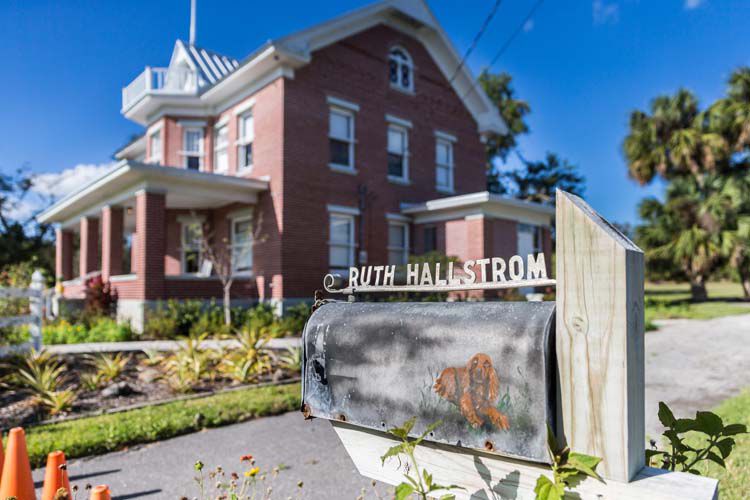
The Hallstrom Farmstead has weathered many a storm over the years, but on the eve of its 2018 centennial anniversary, plans by the Indian River County Historical Society for a year of celebration came to a screeching halt. On Feb. 2, tourists were enjoying a tour of the historic home when the ceiling in the parlor came crashing down.
“One group was upstairs with a docent and heard a huge crash. The other group had walked out of the parlor seconds before it happened. Fortunately, nobody was hurt,” said docent coordinator Al Smith, as he hefted a small portion of the ceiling, weighing several pounds. “When I got here they were all still white as ghosts.”
County Historian Ruth Stanbridge added, “A train had just gone by and we think nearly 100 years of vibration from it finally shook things loose.”
The good news – a structural engineer has inspected the house and found it to be structurally sound. The bad news – the insurance company won’t cover the cost of the damage.
“They said the damage was due to age, so it wasn’t covered,” explained, Carolyn Bayless, IRCHS board president.
Meanwhile, the house remains closed indefinitely as estimates are gathered and a restoration plan approved. The remaining parlor ceiling will eventually need to be removed and boards will need new nails before a new ceiling can be installed. Once up, the ceiling must cure for a month before it can be painted.
Repair costs for the ceiling, chandelier, rewiring, rug cleaning, replacement window and frame, blinds and furniture repair is estimated at roughly $15,000. All they need now is funding to proceed.
Adding to the expense and difficulty of the project, repairs must meet preservation standards to maintain the historical integrity of the house. Horse hair was used as a binder in the original plaster, but that process is no longer feasible.
“We think the horse hair deteriorated and that’s why the ceiling weakened,” Stanbridge explained.
“Normally at this time of the year we have eight to 10 people a day coming through, which is funding that we are losing by having to be closed at the height of our tourist season,” said Bayless.
The Hallstrom family played a significant role shaping the history of the county and the development of the citrus industry. An immigrant from Sweden, Axel Hallstrom came to the U.S. in 1898, eventually making his way to Viking in St. Lucie County, where he grew pineapples.
Devastated by the passing of his wife Emily in 1908, Hallstrom purchased 40 acres in what was then called Oslo to grow pineapples. After several harsh freezes, Hallstrom planted one of the first citrus groves in the area, which soon replaced pineapples as the primary cash crop.
It was in the two-story Victorian-style home built atop the Atlantic Coastal Ridge on Old Dixie Highway that his 4-year-old daughter Ruth lived until her death in 1999.
“Because they were so close to the railroad, he had access to electricity; the house was wired when it was built. That’s pretty uncommon,” said Smith. “And because they had electricity, they could run a pump and have an indoor toilet.”
Other than two years at finishing school, Ruth lived in the house her entire life. She took a boat to Orchid each week and taught in a one-room school house that still sits on property owned by the Michael family. After Axel died in 1966, Ruth managed the family citrus groves.
Ruth was very active in the community and was a longtime member of the Garden Club of Indian River County. She was a charter member of the Historical Society, and to honor her family legacy left the home and its outbuildings to the organization. The property and its contents include artifacts chronicling early pioneer life through photographs, documents, furniture, tools and memorabilia.
IRCHS members took their duty to protect and preserve this historic site to heart, and over the past 17 years have restored the home and brought it back to life through St. Lucia Day activities, traditional Swedish teas, a Pineapple Celebration and Name Day.
Looking to the future, Stanbridge noted, “We hope to raise enough money to also move forward with plans to turn the Carriage House into a meeting room and coffee shop and build an outdoor kitchen.”
They estimate it will cost another $15,000 to convert the carriage house and $10,000 to build the outdoor kitchen. These additional features will enhance the property and enable revenue to sustain the farmstead through expanded community events and rental opportunities for weddings, birthdays and family reunions.
“We may be 99 and holding, but we’ve got some exciting things planned,” said Stanbridge of their centennial ideas.
Board member Pat Kroeger is writing a one-woman play about Ruth, a historical marker will be placed on the property, the Pineapple Celebration promises to be bigger than ever, and a Corvette Show is in the works.
Recently, the county has been working to create a nature trail on the 100 acres surrounding the Hallstrom House. The property cannot be developed because it contains several endangered species, including gopher tortoises, scrub jays and a rare mint plant found in only a few places in the world.
A partnership with the county, which would include the addition of public bathrooms that could be used at farmstead events, would benefit both groups.
The late civil rights activist Marcus Garvey once said, “A people without the knowledge of their past history, origin and culture is like a tree without roots.”
The Hallstrom family put down roots in this community more than 100 years ago and the preservation of those roots will help bond generations to come with a shared sense of community.
Donations to repair Hallstrom House, which will remain closed until they are completed, may be made to the Indian River Historical Society through Oculina Bank or by calling 772-778-3435.



